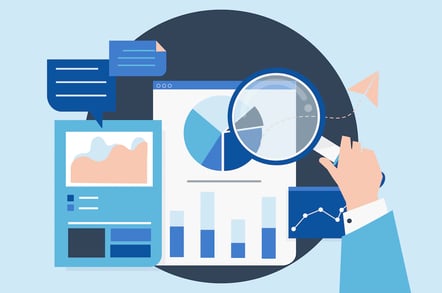How to Do an Accounts Receivable Analysis
A good accounts receivable operation continuously evaluates how a business is doing and uses data to determine effective things. It also determines the problems in the company's finances and the things affecting business finances. A thorough analysis of the A/R will reveal efficiency that might not be apparent and let your business increase its productivity without adding resources.
This method's consequence is a better cash flow, which can allow you to grow your company. A thorough and constant knowledge of the efficiency of your A/R processes isn't a huge amount of money. However, the advantages can have a broad impact on your company.
What Is Accounts Receivable Analysis?

Receivables are the sums due to a company from their customers. Accounts receivable analysis is composed of a potentially large amount of invoice. Receivables are the main source of inflowing money for most firms, so you must analyze the invoices properly to determine the quality of your company's cash flow. This blog will explain how to do an accounts receivable analysis.
Key Points
- The term "accounts receivable" refers to the amount of money that a customers owe the business for products or services that are already offered to them.
- Examining the company's accounts receivable can assist investors in getting an understanding of the company's financial stability and liquidity.
- The ratio of accounts receivable to sales allows investors to determine the extent to which sales of a company aren't yet paid for.
- Companies with diversified costumer base could be less prone to risk as compared to those businesses whose accounts are owed to customers primarily in a certain segment.
How To Analyze The Aging Report?

One of the most efficient ways to assess the condition of an organization's receivables can be to create an accounts receivable ageing report. It is a common report found within any accounting software program. The report splits the age of receivables into various buckets, which you can modify within the accounting software to correspond with the billing terms you have set.
The most frequent buckets range from 0-30 days, 31-60 days, 61-90 days, and over 90 days. Invoices that fall in the time buckets that cover longer period of time like 30 days can become the reason for growing anxiety, particularly when they fall into the older time buckets like 90 days. There are various issues to consider when a company is analyzing an older report. These issues are mentioned below.
Individual Credit Terms
Management could have approved long terms for credit for particular customers or certain invoices. If that is the case, these items appear to be due for payment when they're not paid.
Distance From The Billing Date
In a majority of firms, invoices are paid by the end of each month. If you check the old report just a few days later, it's likely to display still outstanding accounts receivables from the previous month, for which the payment is set to be made and the entire amount of receivables just invoiced. Overall, receivables have fallen into an unsatisfactory state. If you run the report before the month-end billing process, it would show fewer accounts receivable on the report, and there might be less amount of cash flowing from receivables that are not collected.
Time Bucket Size
It is best to approximate the length of time buckets listed in the report with the business's terms of credit sales. For instance, If credit sales terms are only ten days and the initial time bucket covers 30 days, most invoices will appear current.
Unapplied Credits
There is unapplied credit in the report. If so, arrange the report by determining the invoices to which they should have been applied. This could decrease the number of late receivables on the report.
How To Conduct A Accounts Receivable Trend Analysis?

Another analysis tool for accounts receivables includes trend line analysis. For this, you have to plot the balance sheet of outstanding accounts receivable at the close of each month for the last year and use it to determine what amount of accounts receivable will be due within the next few months. This is a valuable tool if your sales are seasonal because you can use seasonal variation to forecasts the future levels of sales.
The trend analysis is also helpful in comparing the sales proportion of bad debt over a certain period of time. If there is a clear pattern of recurring trends in this percentage, the management might want to do something about it. For instance, if the percentage of bad debt rises, management might decide to grant stricter terms for credit to customers.
If the percentage of bad debt is low, the management might decide to ease credit to increase the sales of potentially riskier customers. This is an especially beneficial tool to analyze bad debt percentage for each customer, as it may reveal problems that could signal a client's near financial ruin.
There are many things to consider when using trend line analysis. These are discussed below.
Change In Credit Policy
If the management has approved an amendment to existing credit policies, that could result in sudden changes to the accounts receivable and bad debt levels.
Change In Products Or Business Lines
If a business adds or removes from its range of business lines or products, This could result in significant shifts in the direction of receivables.
Change In Business Conditions
When the economic situation is declining, there could be an increase in bad debts that are well over the average historical rate
How To Conduct A Ratio Analysis
The third kind of analysis on accounts receivables includes an analysis of ratios. The most frequently used ratio is the receivable collection period, which shows the number of days an average invoice from a customer remains in the balance sheet before it is paid. It is calculated as follows:
(Average accounts receivable/ Annual sales)×(365 days)
Let's take an example here. Let's suppose that a company have an outstanding balance of $300,000 of accounts receivable balance and the company's annual sales are $2.5 million, then the accounts receivable balance collection period will be
= (300,000 average accounts receivable/2500000 Annual sales) ×365 days
= 43.8 days or ≅ 44 days
The best method of analyzing receivables is to employ the three methods described in this blog. Accounts receivable collection time gives an idea about the capability of a business to pay its accounts receivable. It also gives an idea about which invoices are causing collection issues and includes trend analysis to determine whether there is any progress in resolving these issues.
Other Types Of Analysis
A fascinating thing about accounts receivable analysis is the trend line showing the sales ratio made by customers that are paid out at the point of sale and the type of payment used. Modifications to a company's selling practices and procedures could lead to shifting sales towards or away from upfront payments. This can affect the size and character of the accounts receivable.
The Bottom Line
The top accounting software offers numerous features that make handling the daily data entry task easier. The flexibility and freedom you require allows you to focus on the most important business activities, ultimately giving you an edge in the market.
We've reviewed the top five top-wave accounting solutions that will transform the demands of your business. Each software also comes with the opportunity for a trial period, so do not be concerned and make your choice after making the one you like best.
ZarMoney is your best bet if you leave for us to guide you. It is easy to use and includes wide functionality and scalability to cater to all your business’s accounting needs.
Overall, ZarMoney has outstanding reviews, affordable pricing, and an interactive user-friendly dashboard design, making it easier for you to do an accounts receivable analysis. It’s an economical and rewarding choice for small businesses.
FAQs
What are the best account receivable analysis techniques?
The best strategy for managing accounts receivables is to keep track of receivables in advance of when they are deemed delinquent, which can result in cash flow issues. When accounts are delinquent, the collection team of your company should be able to collect them quickly. If debts remain unpaid for a long period, there is a chance that your debt collection is low.
How to find average accounts receivable on the balance sheet?
Average accounts receivables are calculated by calculating an average of beginning and closing receivables for the specified time (generally each month or quarterly) multiplied by 2. In financial modeling, the turnover of accounts receivable percentage is utilized to create forecasts of balance sheets.
How to include account receivable in an income statement?
You can't include accounts receivables on a balance sheet. The reason is that income statements are meant to be used for expenses and revenue, and accounts receivables are not. When a company makes a sale, they report the sale as revenue on their earnings statement.

